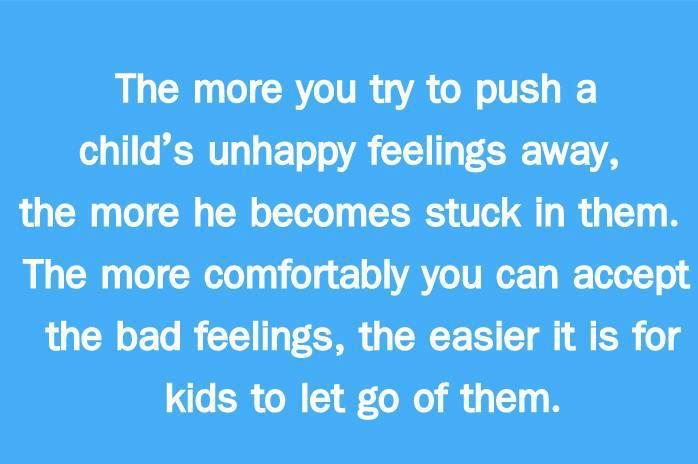|
1. Ask them to tell you how they feel.
Ask your children to show you their emotions. Let them express themselves to you. When they seem to have something on their mind ask them about it. 2. Don’t make them feel as if they are doing something wrong by feeling the way they do. Your children cannot stop their emotions from coming. Just because you don’t think they are reacting to something how you would or how they should doesn’t mean they are wrong for feeling the way they do. They are their own people and you should remind yourself of that. 3. Teach them to recognize their emotions. You need to teach your children to label the things they’re feeling. When they’re mad make sure they know that’s what they’re feeling. Don’t let them go through the motions unable to express themselves properly. 4. Do not squash their individuality. Let your children express themselves. Do not step all over who they are. If they want to wear red hair clips, let them. Don’t force them to wear green ones just because you like them better. 5. Use feeling words when you speak to them. When you’re feeling something make those feelings known. Label your own emotions so your kids will know what is going on within you as well. Don’t leave them guessing. 6. Stress the importance of positive self-talk. Remind your children time and time again how important it is to talk positively about themselves. When they’re upset or stressed they need to know how to remind themselves that things will be alright. They need to be able to motivate themselves. 7. Talk about uncomfortable emotions. Be willing to talk about the things your kids might consider to be uncomfortable. Sure, sadness doesn’t feel good but it is unavoidable. They need to know that they are not alone. 8. Allow them to express themselves through art and other things of the sort. Let your kids express themselves properly. Make sure they have some kind of outlet. This could be music, art, or anything else that they take interest in. 9. Talk to them about how you handle your emotions. Talk to your children about how you handle your own emotions. Make sure they know that you work to cope with the things you’re feeling properly and how important that kind of thing is. They should know that bottling their emotions is not a good thing to do. 10. Spend time outdoors together.Being outside is something that helps to relax people big time. Making sure your kids know the importance of being in nature and spending time with the people they care about. While it might not seem like much at first as time passes it will work wonders. 11. Set a good example emotionally, don’t overreact or lash out. Set a good example for your kids. They react to the way you act and will change themselves sometimes in order to mimic you. If you are handling your emotions properly they will also be able to work towards the same. 12. Set boundaries with your children without dismissing them. Make sure your kids know that when it comes to their emotions they need to think before they act. Just because they might feel bad doesn’t mean they should lash out. There are consequences for everything we do. 13. Make sure they are comfortable coming to you to talk about this kind of thing. Be there for your kids and make sure they know that they can come to you. They need to feel safe and secure with you. They need to know that you will not judge them. 14. Use the shows, books, and other things your children like to go over emotions. Use things they like to help them relate better. If they see someone sad on a show ask them how that makes them feel. Teach them in the ways you feel they need. Go over emotions and make sure you don’t forget any of them. Reprinted from https://awarenessact.com/stop-teaching-children-to-never-be-angry-teach-them-how-to-be-angry/ December 10, 2015
Ways We Numb Ourselves Emerging from the Grey by Madisyn Taylor Numbing yourself prevents you from confronting your issues and keeps you from ever finding resolution or peace. We are born equipped to experience a complex array of diverse emotions. Many of us, however, are uncomfortable confronting our most powerful emotions. We may shy away from delight and despair and deny life's colors by retreating into a world of monotone grey. We may numb ourselves to what we are truly feeling. It's easier to suppress our emotions than to deal with them, so we may momentarily turn to pleasures such as alcohol, food, sugar, shopping and too much television. We may even numb our hearts. While it's normal to temporarily seek distractions as a means of coping with intense emotions, numbing yourself prevents you from confronting your issues and keeps you from ever finding resolution or peace. When you are numb, there is no pain or powerlessness, but there can also be no joy or healing. The activities that numb you may seem harmless or pleasurable, but using them to numb yourself diminishes the quality of your life. Numbing yourself so that you don't have to feel intense emotions can often satisfy a surface need while blocking your awareness of a deeper need. You may find solace in food or shopping when what you really need is spiritual nourishment. The less you feel, the less alive you feel. Your feelings add vividness to your experiences and serve to connect you to the world around you. It is possible to disavow yourself of numbing behaviors a little at a time and once again taste life's rich flavors. When you sense that you are engaging in a particular behavior simply to deaden your emotions, stop and ask yourself why. Examining the feelings that drive you to numb yourself can help you understand what is triggering your desire to emotionally fade out. With each numbing activity that you cut out of your life, you'll find yourself being more aware and experiencing a greater emotionally acuity. Senses once shrouded by the fog of numbness become sharp and acute. Traumas and pain long hidden will emerge to the forefront of your consciousness and reveal themselves so that you can heal them. You'll discover a deeper you a self that is comfortable experiencing and working through intense emotions with courage and grace. Madisyn Taylor writes a newsletter Daily OM, Nurturing Mind, Body and Spirit. Video from KarmaTube
"Your blood keeps pumping because, like, you're really mad. And you start to get sweaty because you're getting really, really mad. And then when you start getting really mad, you turn red." Entirely un-scripted, this video was filmed on a Saturday afternoon with students of Citizens of the World Charter School in Mar Vista, California, and their families. These 6-year old kids began learning mindfulness techniques in Kindergarten and can teach us all a thing or two about coping with difficult emotions.
The term “Emotional Metabolism” affirms that we are constantly experiencing a flux of emotions generated from within, and we experience emotions that impact us from the outside – the feelings of others. And emotions must be processed just as we need to process any food that enters our system.
Our emotional metabolism is the part of us that does its best to take in the emotions that work for us, while protecting against the kinds of emotions that bring us down. In other words, feelings of all kinds must be digested, assimilated, and if they don’t serve us – neutralized and excreted. - See more at: http://psychologyofeating.com/what-is-emotional-metabolism-video/#sthash.FCIkFJdK.dpuf I recently watched Amy Cuddy's TED talk about How Your Body Language Shapes Who You Are. She talks about powerful body language both as others perceive you and as you perceive yourself. I would use this information when using Powerfull to talk about building confidence. I would also use it to discuss difference between feeling powerful and feeling powerless.
Love her quote "Fake it unless you become it.!" Watch here Amy Cuddy talk. Check out Karla Mclaren's blog for May 15th. She discusses a term called emotional weasel words. Read it here http://karlamclaren.com/stress-is-a-weasel-word-and-maybe-thats-good/
Daniel Goldman says that emotional intelligence includes, “the ability to control impulses, delay gratification, motivate self, read other people’s social cues, and cope with life’s ups and downs”. Learning how to express how you feel in appropriate ways is a life skill that will help you to make healthy choices for yourself. Sharing how you feel with others creates connection and encourages the development of safe, caring relationships. Do not assume that the children know how to do this. You will encourage emotional communication and offer support to the children you teach listening, empathy and communication skills.
When you teach a variety of ways to express all feelings you are giving children skills that can be used for a lifetime. What follows are suggestions for ways to practice expressing emotions. Teach about learning styles and Gardner’s theory of multiple intelligences so that each child can learn about their own style of learning and expressing feelings. For example: - An auditory person would want to talk about his or her feelings. - A visual person might want to show you how he or she feels with pictures. - A kinesthetic person might want a hug or sit close to you or need to express his or her feeling with movement. The arts are a rich resource for expressing emotion. - Drawing, painting, clay - Dance, movement, exercise - Poetry, creative writing - Puppets, plays, drama - Music, singing, humming, play an instrument, drum Breathing. We hold our breath in an attempt to keep a feeling from releasing. Try these to use breath to express emotions or release them. - Count to ten and breath - Hold breath for 10-20 seconds and then blow out very slowly - Take slow breaths in through nose; blow out slowly through mouth - Sing, whistle Play/Movement – especially in nature - Talk a walk or run - Walk through a park, pick up sticks and stones that appeal to you - Play on a playground - Exercise - Throw rocks in a lake; throw cotton balls (and pick them up) - Wad up large pieces of newspapers |
Barb Kobe and
|



 RSS Feed
RSS Feed
